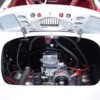Lads, I've got an approx. 1983 IM with a stock 1600 engine. We just put the engine back in having had to change the oil cooler seals and my helper enquired about the engine compartment baffles. I'm referring to the baffles or seals that surround the engine and more or less separate the upper part of the engine compartment from the outside elements below the engine. Is there any purpose to them other than to keep some road grime, dirt, rain etc. from getting at the top of the engine? If they were totally sealed up, like perfectly, how would the carb or cooler fan get any air to do it's job. My engine compartment lid ( hood ? ) has a false grill and can't admit air. I searched the airchives and found no advice. Ron O'Black..you have an older IM. Could you or anyone else please describe what should be there? Right now there's a bit of a 1/4" panel roughly cut to fit the rear end and it has a large inner tube to provide a bit more of a seal around the sides and rear end. Thanks...Dave Stroud.
Original Post


